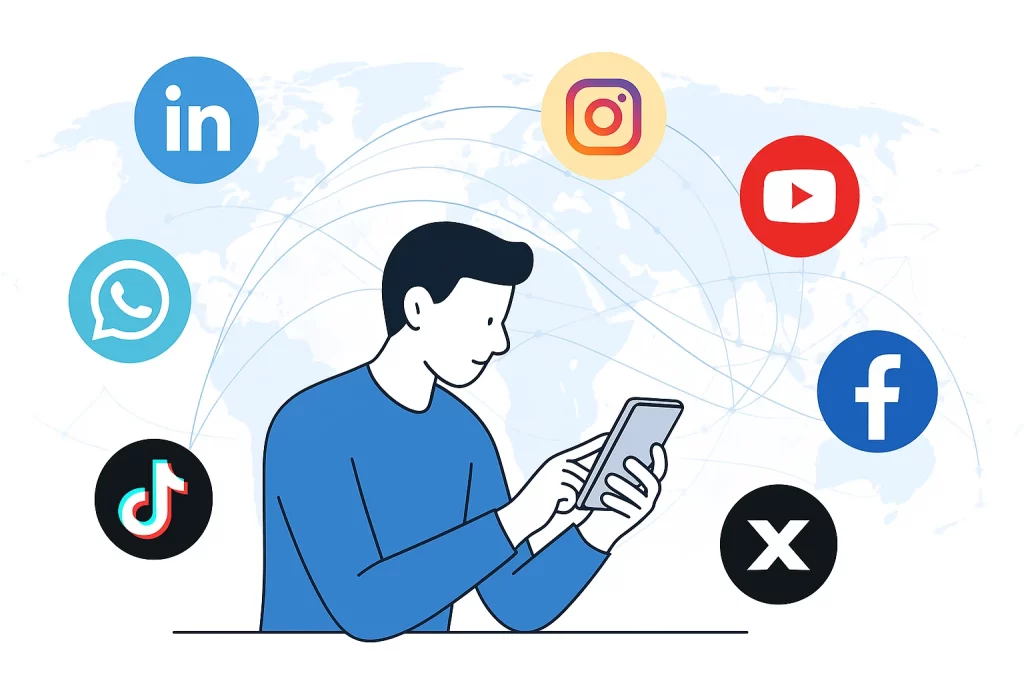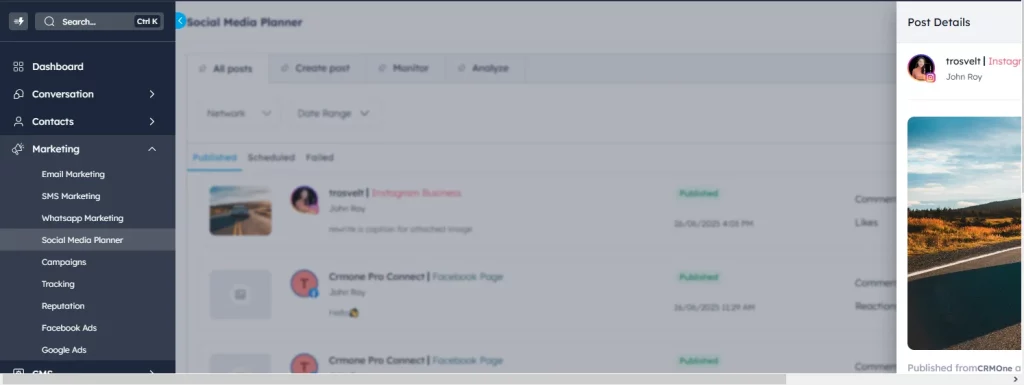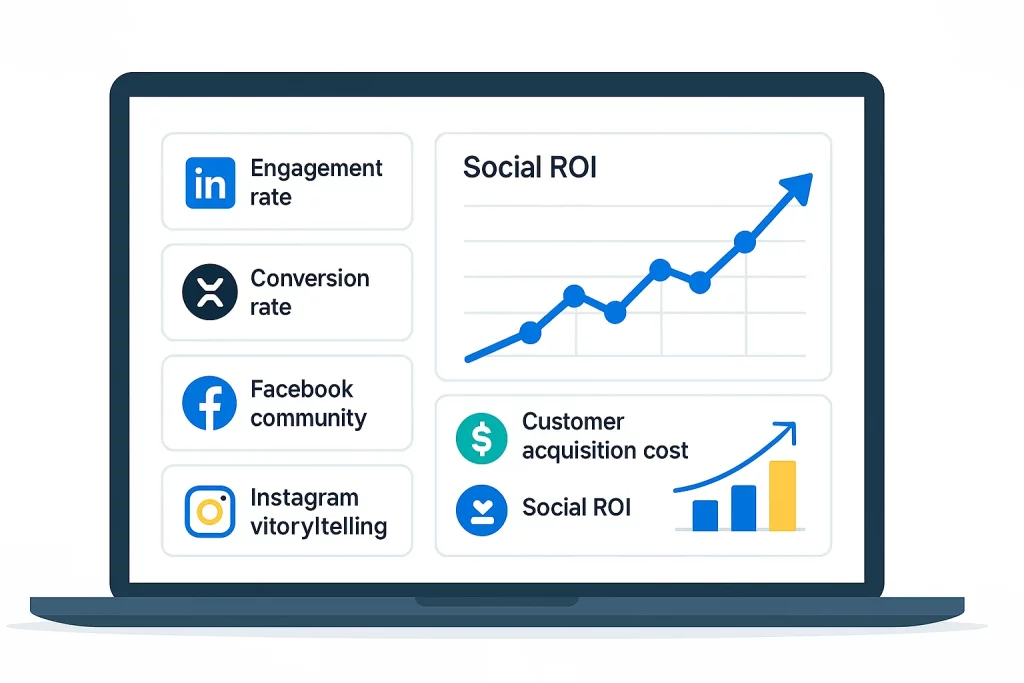‘I will definitely buy this.’ Everyone has this feeling at some point in time, when we see an attractive product on social media, right? It’s magical marketing!
Who would have thought we would scroll and shop? This is a vast opportunity for businesses, and they are leaving no stone unturned.
There are 5.24 billion active users. They spend about 143 minutes each day scrolling through their feeds. From large enterprises to small businesses, everyone has shifted to online.
Why? It’s easier to showcase your products along with features. You get a wider audience.
Why be limited? When can you impact globally? But not every business knows how to take advantage of social media.
Yes, they are creative. They post every day and make engaging reels. But will prospects buy from them? Many factors influence this, like demographics, trends, reviews, and the back-office software you use.
Are you doing what it takes to scale up? This guide will help you turn your social media efforts into real business growth.
What is Social Media Management?

Social media management means making, sharing, watching, and studying content on social media sites. This helps achieve business goals. Every element from content creation to crisis management needs to work together perfectly.
If not, then you are just putting your capital down the drain.
Brian Solis, a digital analyst and author, emphasises the wide range of skills needed. He says, “Social media is about sociology and psychology more than technology.”
You have to input tech with creativity. Keep on learning with every campaign, find out what went right and wrong, and discuss with your team.
Customers are now more concerned with personalization, rather than generic feeds.
Why Social Media ROI is Make-or-Break for Your Business Success?
Beyond Vanity Metrics
If you have been just focusing on likes, shares, and follower counts, then it’s time to rethink. These metrics alone won’t grow your business.
Actual ROI comes from conversions, customer acquisition, and lifetime value increases. It’s about turning social engagement into actual revenue.
The Multi-Platform Reality
The average person uses 6.8 social media platforms every month. Be present on multiple platforms for more reach.
This means your social media management strategy needs to be cohesive yet platform-specific. Each channel requires tailored content and engagement tactics.
Essential Skills Every Social Media Manager Role Demands
Strategic Planning
The real impact of business is what matters. You build a brand by setting high standards and infusing a thought of ‘trust’ among customers.
Data Analysis
Turning all those likes and shares into insights people actually care about. The goal is to transform raw social media data into actionable business intelligence.
Community Building
Creating genuine relationships at scale (yes, it’s as hard as it sounds). This involves fostering authentic connections while managing hundreds or thousands of interactions.
Crisis Management
Respond fast and have control when things go sideways online. Your team should think quickly and act accordingly when it’s about brand reputation.
An example of crisis management is Slack’s handling of its significant service outage in February 2022.
When users lost access, Slack responded quickly. They posted status updates every 30 minutes. They also used Twitter to admit mistakes, apologise, and share progress.
This fast and clear approach built user trust. It showed that they could handle their brand reputation in a crisis.
Cross-functional Collaboration
When we talk about managing, it’s crucial to analyze internal departments. There should be a smooth flow of communication among marketing, sales, customer service, and the product manager.
Yes, the social media manager is the one responsible, but as a part of business, everyone has a role to play in it.
Technology Integration
Using AI and automation without sounding like a robot. The challenge is leveraging technology to scale efficiency while maintaining human authenticity.
The 6 Core Pillars of Effective Social Media Management
1. Strategic Foundation and Audit

Before you create a single piece of content, you need a solid foundation. I know audits aren’t sexy, but they’re essential.
Here’s what actually works:
Current State Analysis
List every social profile you own, even the random ones made in 2015. Track performance data from the past 1 year.
Find out both positive and negative things in your campaigns. Even one bad post is enough to ruin your reputation.
Goal Setting Framework
Seek a 15-20% growth in reach, impressions, and share of voice each quarter.
Aim for a monthly rise of 5-10% in comments, shares, and community growth.
Conversion Goals: Lead generation, demo requests, pipeline influence (and yes, track attribution properly).
Retention Goals: Customer satisfaction scores, response times (keep it under 2 hours average).
Sales Team Integration
A quick note for SDRs and AEs: Your social strategy must back your sales efforts. If it doesn’t, you’re doing it wrong.
Map social touchpoints to every stage of your funnel.
2. Platform Selection and Optimization: Mastering All Social Media Platforms
Not all social media platforms are created equal for B2B. Here’s the real breakdown based on actual data:
LinkedIn (Your B2B Workhorse)
It dominates B2B marketing and professional networking. Even Microsoft uses it to share expert knowledge and connect with decision makers.
900M+ professionals, with 4x higher website visit rates. 80% of B2B leads come from LinkedIn.
Best for: Thought leadership, ABM campaigns, humble brags about your latest win. Post 1-2 times daily on weekdays.
X/Twitter (The Real-time Conversation Hub)
A perfect medium for getting quick updates and joining trending conversations. But for brands, they should be aware that customers expect fast responses.
Wendy’s and Nike use X for customer service and maintaining brand personality. They also engage in trending topics to stay relevant and get more visibility.
600M+ active users with 67% following brands. People expect responses within an hour (no pressure).
Best for: Customer service, jumping into industry convos, news jacking. Post 3-5 times daily.
Facebook (The Surprising B2B Player)
Facebook’s advanced targeting and big user base are key for digital ads. Brands like Dollar Shave Club and Warby Parker grew from startups to well-known names.
They used Facebook’s targeting tools and engaging videos to reach more people.
3B+ users with 200M+ businesses active. Here’s what shocked me: 74% of professional decision-makers use Facebook.
Best for: Community building, event promotion, and those longer video explainers. Post 1-2 times daily.
YouTube (The Underutilized Giant)
After Google, it’s YouTube that people go to for searching anything. I am a big fan myself.
A platform that uses video and reels too to teach valuable skills and even long tutorial lectures.
Blendtec and GoPro became famous because of Youtube. Their videos went viral on this platform.
2.5B+ users watching 1B+ hours daily. 70% of B2B buyers watch videos during their purchase journey.
Best for: Product demos, tutorials, and thought leadership, if you’re comfortable on camera. Post 1-2 times weekly.
Instagram (The Visual Storytelling Platform)
Instagram is all about visuals. That’s why it’s the top choice for lifestyle and product marketing.
Features like Stories, Reels, and Shopping tags drive direct sales.
Glossier and Fashion Nova became multi-million-dollar brands by partnering with influencers. They also highlighted content created by their users.
2B+ users with 90% following at least one business. Growing B2B presence, especially for showing your company isn’t all spreadsheets.
Best for: Company culture, visual case studies, behind-the-scenes content. Post 1-2 times daily.
TikTok (Yes, Even for B2B)
The viral term got more famous because of TikTok. Creativity combined with authentic content, and you have got yourself customers lining up.
Brands like Chipotle and Ocean Spray had big sales boosts from TikTok trends. This shows how the platform can quickly get consumers to act.
1.5B+ users with the fastest-growing B2B audience. 55% of B2B companies plan to increase TikTok investment in 2025.
Best for: Educational content, trend participation, proving you’re not stuck in 2010. Post 1-4 times daily.
WhatsApp (The Conversational Commerce Giant)
WhatsApp Business helps brands connect closely with customers.
It does this through direct messaging and automated support.
Zara and Netflix use it for personalised service, order updates, and exclusive content. This turns messaging into a sales channel.
2.95B+ users and over 200M active businesses worldwide.
Key highlights are: 98% open rates for marketing messages and 45–60% click-through rates.
These figures exceed those of many other digital channels. About 175 million people message businesses on WhatsApp daily.
Best for: Direct customer support, Conversational marketing, Fast order recovery, Send timely, personalised messages.
3. Content Creation and Curation Excellence
Content is your currency, but most B2B companies are broke. The Content Marketing Institute found that companies with a written content strategy are five times more likely to see themselves as effective.
So let’s fix that.
The 70-20-10 Rule That Actually Works
70% Value-Add Content: Teach something useful, solve a problem, or share insights they can use right away.
20% Curated Content: Include industry news with your opinions and partner content that showcases your knowledge.
10% Promotional Content: Yes, only 10%. I know it hurts, but trust the process.
Content Types That Actually Perform
Data-Driven Insights: Original research gets 3x more engagement—people love exclusive data.
Problem-Solution Stories: “Here’s a specific problem. Here’s exactly how to fix it.”
Interactive Content: Polls and Q&As boost engagement. People love sharing their opinions.
Employee-Generated Content: Your team’s posts get 8x more engagement than your brand.
Customer Success Stories: 92% of B2B buyers are influenced by case studies, and use them.
Behind-the-Scenes Content: Shows you’re actual humans, not corporate robots.
4. Social Listening and Monitoring
Stop treating social listening like it’s optional. Here’s how to turn noise into intelligence:
Brand Intelligence Metrics
Track everything—branded and unbranded mentions. Monitor sentiment (aim for 70%+ positive, but be realistic).
Measure share of voice vs. competitors. Spot potential crises before they blow up.
Market Intelligence Gold
Trending topics in your industry. What competitors are doing (and failing at).
Customer pain points they’re literally telling you about. Gaps in the market nobody’s addressing.
Sales Intelligence for Revenue Teams
Buying signals (they’re everywhere if you look). Job changes at target accounts.
Competitors’ unhappy customers. Decision-makers are engaging with your content.
5. Analytics and Performance Measurement

Data without action is just numbers on a dashboard. Focus on what actually matters:
Metrics That Move the Business
Engagement Rate: (Total Engagements / Reach) × 100 (1-3% is solid for B2B). Conversion Rate: (Conversions / Clicks) × 100 (2-5% is the target).
Customer Acquisition Cost: What you spent / New customers you got. Pipeline Influence: % of deals with social touchpoints.
Customer Satisfaction Score: From social support interactions. Share of Voice: Your mentions / Total industry mentions × 100.
Monthly Reporting That People Actually Read
- Executive Summary (3 wins, three learnings, three things we’re doing next).
- Goal Performance Dashboard (red, yellow, green, keep it simple).
- Top Performing Content (so we can make more of it).
- Audience Growth and Demographics.
- How we stack up against competitors.
- What we’re focusing on next month.
6. Automation and AI Integration
AI is a game-changer, but it’s not a replacement for humans (yet). Gartner says 80% of social media management tasks will be augmented by AI by 2025.
Here’s what to automate and what to keep human:
Automate These
Content ideation and first drafts. Finding optimal posting times.
Basic reporting. FAQ responses.
Social listening alerts.
Keep These Human
Crisis response (never let a bot handle an angry customer). High-value customer interactions.
Brand voice and storytelling. Strategic decisions.
Building relationships with key accounts.
Building Your Ultimate Social Media Tech Stack for Maximum ROI
The right tools can 10x your productivity. Here’s what actually works at different scales:
Centripe.ai: All-in-one social media management platform.
Sprinklr: The Rolls-Royce of social media platforms.
Sprout Social: Best analytics I’ve seen. Hootsuite: The OG that still delivers.
HubSpot: If you’re already using their CRM, it’s a no-brainer. Agorapulse: Incredible for community management.
Buffer: Simple, effective, doesn’t break the bank.
Canva: For when you need visuals yesterday. Brandwatch: Social listening on steroids.
Planable: Makes collaboration actually work. Later: Visual-first scheduling that just makes sense.
Game-Changing Trends Shaping Social Media Management in 2026
1. Social Commerce Is Here
LinkedIn says 40% of B2B buyers are now comfortable buying directly through social. That’s huge.
A fundamental shift, I must say. The B2B purchasing decisions have now shifted to online buying. So, these platforms are now sales channels and not just marketing tools.
2. Private Communities > Public Feeds
76% of consumers prefer private communities. Those exclusive Slack channels and LinkedIn groups?
They’re where the real conversations happen. Building exclusive communities creates deeper engagement and loyalty.
3. AI Personalization at Scale
I love it when brands know my priority. There are many brands offering the latest trending fashion elements.
But do I buy from one that just showcases their products to me and keeps on bragging about how good it is? No! I buy from brands that know what I want and mix trends with personalization.
Personalized content drives 6x higher transaction rates.
Thanks to AI, we are now more advanced in personalization. They can analyze user behavior patterns to deliver content at optimal times. You might have heard about sentiment analysis, too. One of the best features in AI that I like.
It senses the mood of users. Interacts with them in a way that gives them comfort, just like a salesperson.
4. Video-First Everything
Video gets 1200% more shares than text and images combined. I hate being on camera, too, but the numbers don’t lie.
Short-form video content dominates engagement across all platforms. Live streaming creates authentic connections and drives higher conversion rates.
5. Employee Advocacy as Your Secret Weapon
Companies with employee advocacy programs see 5x more web traffic and 25% more leads. Your team is your best marketing channel; use them.
Employee posts receive 8x more engagement than brand posts. Authentic employee stories build trust and credibility better than corporate messaging.
90-Day Implementation Roadmap: From Zero to Social Media Hero
90-Day Social Media Launch Plan
Month 1: Set Up
- Audit your current social media
- Choose 2-3 main platforms
- Set clear goals and create brand guidelines
- Set up monitoring tools
Month 2: Launch
- Start your content calendar
- Begin engaging with your audience
- Get your team involved
- Track weekly results
Month 3: Improve
- Keep what works, drop what doesn’t
- Fine-tune your approach
- Plan your next quarter
Why Social Media Dominates Marketing and Sales?
Unparalleled Reach and Targeting: Social media links brands to billions of users.
It also provides targeting that traditional media can’t match. Brands can target specific groups and interests. They can track clear ROI and make real-time optimisations.
Direct Customer Engagement: Social media lets brands talk with their audience. This helps them build communities, get feedback, and offer quick support.
This engagement fosters stronger loyalty and turns customers into advocates and organic marketers.
Cost-Effective Marketing Solutions:
Social media marketing costs less to start than traditional channels.
Every business can join easily. There are no barriers. Even small start-ups can compete with bigger brands by being creative and building community.
Real-Time Analytics and Adaptation:
Social platforms provide quick data on how campaigns are performing.
This allows brands to change their strategies fast for improved results. This feedback loop supports continuous improvement and smarter resource use.
Social Proof and User-Generated Content:
Social media enhances word-of-mouth marketing.
It does this through user reviews, shares, and content. These elements create genuine endorsements. Consumers often trust this social proof more than traditional ads. This trust can lead to higher conversion rates.
Costly Pitfalls That Kill Your Social Media
Sydney Sweeney’s July 2025 American Eagle denim ad, with the slogan “great jeans/genes,” went viral for its playful yet controversial wordplay linked to her looks.
Critics accused it of cultural insensitivity, while fans praised its boldness.
Despite backlash, denim sales soared, many styles sold out, and the brand’s value rose by over $200M.
The campaign showed how provocative marketing can cut through the noise and boost sales.
Conclusion
Social media management is carrying on the loads of business expectations, and when done right, it delivers the desired results.
Nike, Apple, Tesla that don’t just sell products but tell a story. Everyone loves a good story behind brands.
When you connect with people, they feel obliged and return the favor by buying from your business. With AI, the impact of social media is reaching new heights. You can now create reels and videos within minutes. It saves costs, schedules, and posts automatically.
Develop a social media strategy, discuss with your team, implement the ideas, and perform tests. It’s a continuous journey, keep up with the pace.
Frequently Asked Questions
• Content creation: 8-10 hours
• Community management: 10-15 hours
• Analytics: 3-5 hours
• Strategy: 5-10 hours
• Mid-market: $5,000-$15,000/month
• Enterprise: $15,000+/month
• Twitter: 3-5 times/day
• Facebook/Instagram: 1-2 times/day
• TikTok: 1-4 times/day
• YouTube: 1-2 times/week
